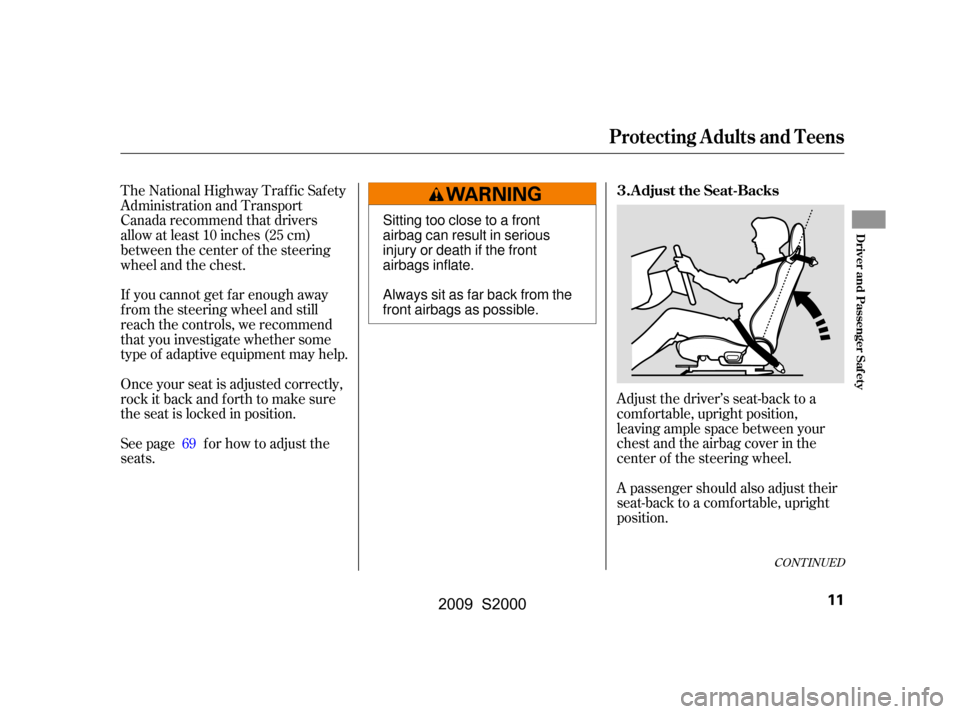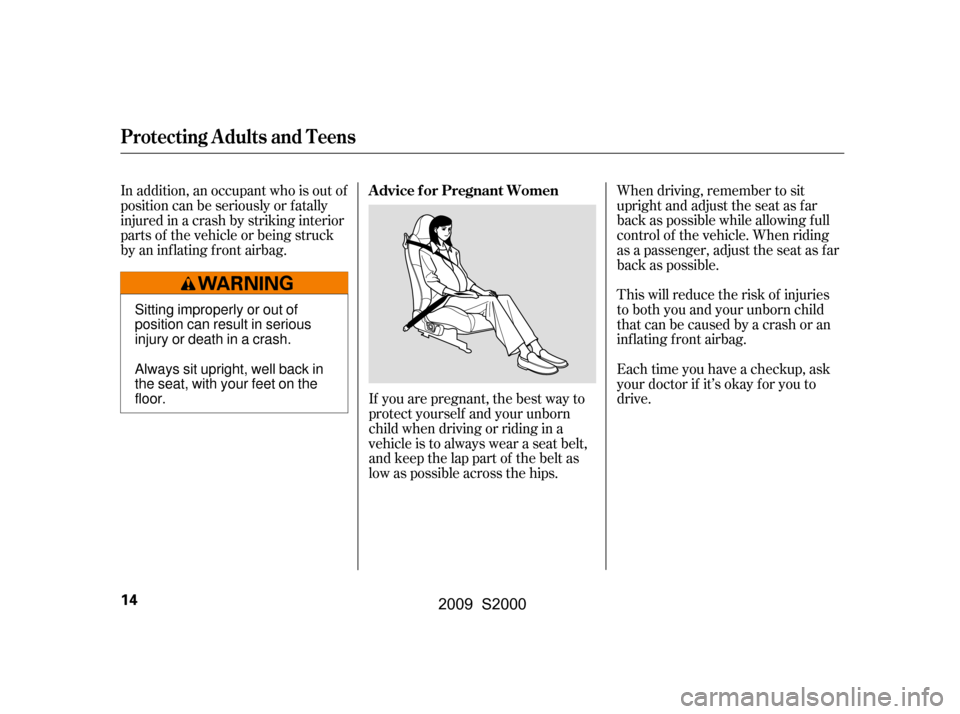Page 14 of 268

Adjust the driver’s seat-back to a
comf ortable, upright position,
leaving ample space between your
chest and the airbag cover in the
center of the steering wheel.
The National Highway Traffic Safety
Administration and Transport
Canada recommend that drivers
allow at least 10 inches (25 cm)
between the center of the steering
wheel and the chest.
A passenger should also adjust their
seat-back to a comf ortable, upright
position.
If you cannot get f ar enough away
f rom the steering wheel and still
reach the controls, we recommend
that you investigate whether some
type of adaptive equipment may help.
Once your seat is adjusted correctly,
rock it back and f orth to make sure
the seat is locked in position.
See page f or how to adjust the
seats.
69
CONT INUED
Protecting A dults and Teens
Adjust the Seat-Backs
3.
Driver and Passenger Saf ety
11
Sitting too close to a front
airbag can result in serious
injury or death if the front
airbags inflate.
Always sit as far back from the
front airbags as possible.
2009 S2000
Page 17 of 268

When driving, remember to sit
upright and adjust the seat as f ar
back as possible while allowing f ull
control of the vehicle. When riding
as a passenger, adjust the seat as far
back as possible.
This will reduce the risk of injuries
to both you and your unborn child
that can be caused by a crash or an
inflating front airbag.
Each time you have a checkup, ask
your doctor if it’s okay f or you to
drive.
If you are pregnant, the best way to
protect yourself and your unborn
child when driving or riding in a
vehicle is to always wear a seat belt,
and keep the lap part of the belt as
low as possible across the hips.
In addition, an occupant who is out of
position can be seriously or f atally
injured in a crash by striking interior
parts of the vehicle or being struck
by an inflating front airbag.
Protecting A dults and Teens
Advice f or Pregnant Women
14
Sitting improperly or out of
position can result in serious
injury or death in a crash.
Always sit upright, well back in
the seat, with your feet on the
floor.
2009 S2000
Page 18 of 268

If they do, they
could be very seriously injured in a
crash.
Devices intended to improve
occupant comf ort or reposition the
shoulder part of a seat belt can
reduce the protective capability of
thebeltandincreasethechanceof
serious injury in a crash. If your
hands or arms are close to an
airbag cover, they could be injured
if the airbag inf lates.
Carrying hard or sharp
objects on your lap, or driving with
a pipe or other sharp object in
your mouth, can result in injuries
if your f ront airbag inf lates.
Objects on the
covers marked ‘‘SRS AIRBAG’’
could interf ere with the proper
operation of the airbags or be
propelled inside the vehicle and
hurt someone if the airbags inf late.
Additional Saf ety Precautions
T wo people should never use t he
same seat belt .
Do not put any accessories on seatbelts. K eep your hands and arms away
f rom t he airbag covers.
Do not place hard or sharp object s
bet ween yourself and a f rontairbag.
Do not at t ach or place object s onthe airbag covers.
Protecting A dults and Teens
Driver and Passenger Saf ety
15
2009 S2000
Page 19 of 268

Your seat belt system includes lap/
shoulder belts in both seating
positions. The seat belts are also
equipped with automatic seat belt
tensioners.
This system uses the same sensors
as the front airbags to monitor
whether the seat belts are latched or
unlatched, and how much weight is
on the passenger’s seat (see page).
The seat belt system
includes an indicator on the
instrument panel and a beeper to
remind you and your passenger to
f asten your seat belts.
This system monitors the seat belts.
If you turn the ignition switch to the
ON (II) position bef ore your seat
belt is f astened, the beeper will
sound and the indicator will f lash. If
your seat belt is not f astened bef ore the beeper stops, the indicator will
stop f lashing but remain on.
If a passenger does not f asten their
seat belt, the indicator will come on
about 6 seconds af ter the ignition
switch is turned to the ON (II)
position.
If eitherthedriverorpassengerdoes
not f asten their seat belt, the beeper
will sound and the indicator will f lash
again at regular intervals.
When no one is sitting in the
passenger’s seat, or a child or small
adult is riding there, the indicator
should not come on and the beeper
should not sound.
If the indicator comes on or the
beeper sounds when the driver’s seat
belt is latched and there is no
passenger and no items on the
passenger’s seat, something may be
interf ering with the monitoring
system. Look f or and remove:
If no obstructions are found, have
your vehicle checked by a dealer.
Any object(s) touching the rear of
the seat-back.
Any objects hanging on the seat.
Any items under the passenger’s
seat.
24
Additional Inf ormation About Your Seat Belts
Seat Belt System Components
16
2009 S2000
Page 21 of 268

For saf ety, you should check the
condition of your seat belts regularly.
For added protection, the seat belts
are equipped with automatic seat
belt tensioners. When activated, the
tensioners immediately tighten the
beltstohelpholdthedriveranda
passenger in place. Pull each belt out f ully and look f or
f rays, cuts, burns, and wear. Check
that the latches work smoothly and
the belts retract easily. If a belt does
not retract easily, cleaning it may
correct the problem (see page ).
Any belt that is not in good condition
or not working properly will not
provide good protection and should
be replaced as soon as possible.
If a seat belt is worn during a crash,
it must be replaced by your dealer. A
belt that has been worn during a
crash may not provide the same level
of protection in a subsequent crash.
Honda provides a limited warranty
on seat belts. See your
booklet f or
details.
The tensioners are designed to
activate in any collision severe
enough to cause the f ront airbags to
deploy.
However, the tensioners can be
activated during a collision in which
the airbags do not deploy. In this
case, the airbags would not be
needed, but the additional restraint
could be helpf ul.
When the tensioners are activated,
the seat belts will remain tight until
they are unbuckled.
184
Honda
Warranty Inf ormation
Seat Belt Maintenance
A utomatic Seat Belt T ensioners
Additional Inf ormation About Your Seat Belts
18
2009 S2000
Page 23 of 268
Additional Inf ormation About Your Airbags
A irbag System Components
20
(1)(2)
(3) (7)
(8)
(6)
(4)
(5) (4)
(6) (9)
(1) Driver’s Front Airbag
(2) Passenger’s Front Airbag
(3) Control Unit
(4) Seat Belt Tensioners
(5) Driver’s Seat Position Sensor
(6) Passenger’s Weight Sensors
(7) Passenger’s Weight Sensor Unit
(8) Front Impact Sensors
(9) Passenger Airbag Off Indicator
2009 S2000
Page 24 of 268

Emergency backup power in case
your vehicle’s electrical system is
disconnected in a crash.
Your airbag system includes: An indicator on the dashboard that
alerts you that the passenger’s
airbag has been turned of f (see
page ).
A sophisticated electronic system
that continually monitors and
records inf ormation about the
sensors, the control unit, the
airbag activators, the seat belt
tensioners, and driver and
passenger seat belt use when the
ignition switch is in the ON (II)
position.
An indicator on the instrument
panel that alerts you to a possible
problem with your airbags,
sensors, or seat belt tensioners
(see page ). Weight sensors that monitor the
weight on the passenger’s seat. If
the weight is about 65 lbs (29 kg)
or less (the weight of an inf ant or
small child), the passenger’s
airbag will be turned off (see page ).
Two SRS (supplemental restraint
system) airbags. The driver’s
airbag is stored in the center of
the steering wheel; the passenger’s
airbag is stored in the dashboard.
Both are marked ‘‘SRS AIRBAG’’
(see page ).
A driver’s seat position sensor that
monitors the distance of the seat
f rom the airbag. If the seat is too
far forward, the airbag will inflate
with less f orce (see page ). Sensors that can detect whether
the driver’s seat belt and the
passenger’s seat belt are latched
or unlatched (see page ). Sensors that can detect a
moderate to severe front impact. Automatic seat belt tensioners
(see page ). 26
24
25
18
24
16
22
Additional Inf ormation About Your Airbags
Driver and Passenger Saf ety
21
2009 S2000
Page 25 of 268

The total time for inflation and
def lation is one-tenth of a second, so
f ast that most occupants are not
aware that the airbags deployed until
they see them lying in their laps.
Although both airbags normally
inf late within a split second of each
other, it is possible f or only one
airbag to deploy.
This can happen if the severity of a
collision is at the margin, or
threshold, that determines whether
or not the airbags will deploy. In
such cases, the seat belt will provide
suf f icient protection, and the
supplemental protection of f ered by
the airbag would be minimal.
If you ever have a moderate to
severe f rontal collision, sensors will
detect the vehicle’s rapid
deceleration.
If the rate of deceleration is high
enough, the control unit will instantly
inflate the driver’s and passenger’s
airbags, at the time and with the
f orce needed. Only the driver’s airbag can deploy if
there is no passenger in the
passenger’s seat, or if the advanced
airbag system has turned the
passenger’s airbag of f (see page ).
During a f rontal crash, your seat belt
restrains your lower body and torso,
and the f ront airbag helps protect
your head and chest.
Af ter inf lating, the f ront airbags will
immediately def late, so they won’t
interf ere with the driver’s visibility,
or the ability to steer or operate
other controls.
24
Additional Inf ormation About Your Airbags
How Your Airbags Work
22
2009 S2000